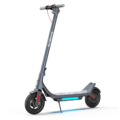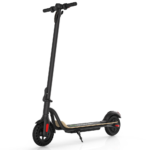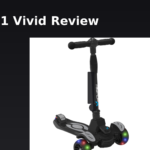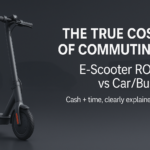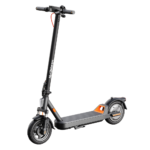- Home
- Scooters
- Electric Scooters
- MEGAWHEELS C2
MEGAWHEELS C2
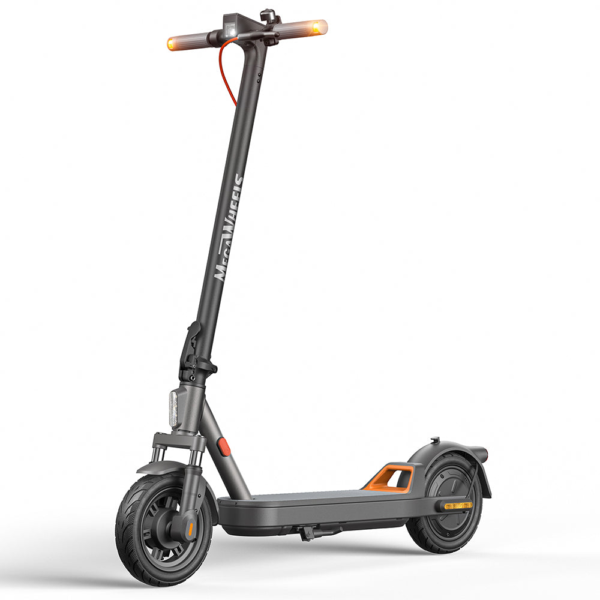

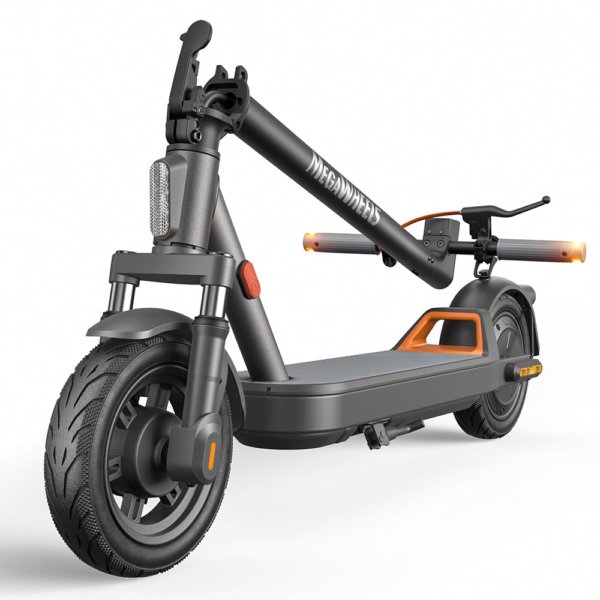
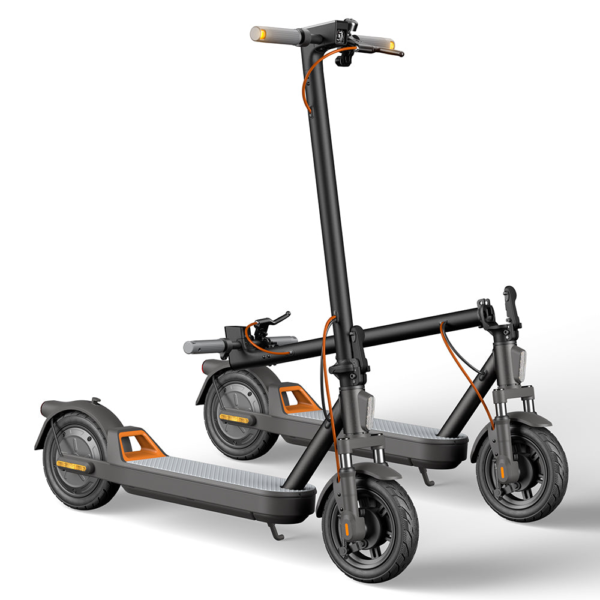
- Battery Range: 19 miles (31 km)
- Top Speed: 15.5 mph (25 km/h)
- Motor Power: 350 W
- Weight Capacity: 220 lb (100 kg)
- Charging Time: ~6 h
- Scooter Weight: 38.8 lb (17.6 kg)
PROS
- 10″ tires with front twin-tube suspension
- App control + LCD display
- IPX5 water resistance
- 220 lb (100 kg) max load
- Compact fold with published folded size
CONS
- Modest 15.5 mph top speed
- Shorter 19-mile range
- Drum + electronic brakes (no disc)
- Heavier than some entry models (38.8 lb)
Table of contents
- What Is the MEGAWHEELS C2?
- How the MEGAWHEELS C2 Works
- Key Specifications
- Design & Build Quality
- Performance Fundamentals
- Battery, Range & Efficiency
- Ride Quality & Comfort
- Braking & Safety Features
- Portability & Daily Usability
- Maintenance & Care
- Weather & Seasonal Considerations
- MEGAWHEELS C2 vs Alternatives
- Who the MEGAWHEELS C2 Is (and Isn’t) For
- FAQs
- Glossary
- Final Thoughts
If you want a simple, sturdy commuter scooter that favors comfort and predictability over flash, the MEGAWHEELS C2 fits the brief. It blends 10-inch pneumatic tires with a front twin-tube shock, a practical drum + electronic brake system, and an easy folding latch. Because it limits top speed to an approachable 15.5 mph (25 km/h), it suits new riders, students, and anyone who prefers calm, confident rides over outright pace. Most importantly, it keeps maintenance light and the learning curve gentle.
What Is the MEGAWHEELS C2?
At its core, the MEGAWHEELS C2 is an entry-level, adult-friendly e-scooter designed for daily travel across city streets, paved paths, and campus routes. The formula is straightforward: a 350 W hub motor (367 W peak), a 21.6 V, 10.2 Ah battery (about 220 Wh), and 10 × 2.125-inch pneumatic tires at both ends for grip and comfort. The front suspension uses a compact twin-tube shock to filter rough pavement edges, while a mechanical drum brake pairs with electronic regenerative braking for smooth, consistent stops. You also get three speed modes and app support for quick settings.
The result is a commuter tool that emphasizes stability at neighborhood speeds, predictable handling, and low-stress ownership. It’s not a racing scooter, and it doesn’t pretend to be; instead, it focuses on control, comfort, and reliability day after day.
How the MEGAWHEELS C2 Works
Electric scooters all share the same building blocks, yet good ones assemble those blocks with care. Here’s the C2 in plain language:
- Motor & Controller. A brushless hub motor in the rear wheel provides the push. The controller meters current to the motor based on how much you twist the throttle and which ride mode you select. Therefore, acceleration feels progressive rather than jumpy.
- Battery & BMS. The 21.6 V pack stores 10.2 Ah (≈ 220 Wh). An onboard battery management system protects against over-charge, over-discharge, and over-current, so daily charging stays straightforward.
- Throttle. The thumb throttle sends your intent to the controller. Hold it steady for a few seconds and, if you enable the feature, cruise control will maintain speed so your thumb can rest.
- Brakes. A drum brake gives strong, weather-tolerant mechanical stopping power, while electronic (regen) braking adds smooth deceleration and feeds a bit of energy back into the battery. You can feather the lever for gentle slowing or squeeze harder for a firm bite.
- Lighting & Signals. A forward LED headlight and a rear warning light improve visibility. Because the system includes a photosensor, lights can switch automatically as ambient light changes. In addition, left/right “winglight” indicators allow clear signaling to others.
Altogether, the C2 feels simple to manage: press power, pick a mode, push off, and ride.
Key Specifications
The figures below come from the manufacturer’s product page and the official user manual and are presented in both imperial and metric units where relevant. megawheels.com+1
| Block | Details |
|---|---|
| General | Model: C2 • Class: entry-level commuter • App: LEQISMART (Bluetooth) • Display: LCD • Water resistance: IPX5 • Recommended rider age: 12+ |
| Performance & Power | Motor: 350 W nominal (367 W max) • Top speed: 15.5 mph (25 km/h) • Ride modes: 3 (Pedestrian ≈ 4 mph / 6 km/h; Standard ≈ 9 mph / 15 km/h; Sport ≈ 15 mph / 24 km/h) • Gradeability: ~15% • Max load: 220 lb (100 kg) |
| Battery, Charging & Electrical | Pack: 21.6 V, 10.2 Ah (≈ 220 Wh) • Charger (rated): ~24.2 V, 1.5 A (≈ 36 W); max charge voltage 25.2 V • Charge time: ~6–8 h from near empty • Claimed range: ≈ 19 mi (30.6 km) under controlled conditions • BMS protections: over-heat/short-circuit/over-current/over-/under-voltage • Lights: front LED, rear warning, auto on/off |
| Build & Dimensions | Frame: aluminum • Tires: 10 × 2.125 in pneumatic (front & rear) • Suspension: front twin-tube shock (≈ 35 mm travel) • Unfolded size: 46.22 × 20.94 × 48.89 in (117.4 × 53.2 × 124.2 cm) • Folded: 46.22 × 20.94 × 21.26 in (117.4 × 53.2 × 54.0 cm) • Net weight: 38.8 lb (17.6 kg) |
| Safety & Control | Brakes: mechanical drum + electronic regen • Indicators: left/right “winglights” • Display shows speed, mode, battery • IP rating: IPX5 |
| Features & Extras | Cruise Control (toggle via app), 3 ride modes, auto-light function, side stand, folding latch with audible “click,” unit switching (mph/km/h) |
| Warranty & Compliance | Manufacturer’s 12-month limited warranty for the original owner; water damage and normal wear excluded; regional riding laws vary. |
Note: The manual defines the typical range test as Standard mode at ~9 mph (15 km/h), 165 lb (75 kg) rider, ~25 °C, flat ground, and no wind. Real-world results will vary with load, speed, terrain, temperature, and riding habits.
Design & Build Quality
The C2’s design is utilitarian in the best way. First, the aluminum frame keeps weight reasonable while resisting daily scuffs. The deck is flat and simple, which makes stance changes easy. Because the twin-tube front shock does the initial smoothing, the deck transmits fewer high-frequency vibrations from cracked pavement. Grip tape is straightforward, and it cleans up fast with a damp cloth.
Next, the stem and latch. The folding handle pulls up until it clicks, then you confirm lock-up with a quick check. This action becomes muscle memory. The stem is rigid enough for entry-level speeds, and the tall bar height helps taller riders stand more upright. As a result, you feel less cramped on longer rides.
The cockpit stays uncluttered. You get an LCD display for speed, battery bars, and mode. The thumb throttle is right under your thumb, and the brake lever sits where you expect. There are dedicated buttons for light and “winglight” indicators, so you signal without shifting your grip. Everything aims to be simple to understand on day one.
Finally, the wheels and tires. With 10 × 2.125-inch pneumatics, the contact patch is generous for this class. Those tires allow modest pressures, which improves comfort and grip on polished concrete and painted lines. They also work well with the front suspension to dull sharp edges. Potholes still demand attention, yet the combo keeps chatter manageable.
Performance Fundamentals
Performance here means calm predictability. In Pedestrian mode, the scooter creeps along for crowded sidewalks and station platforms. Standard mode brings a balanced cruise for neighborhood streets around 9 mph (15 km/h). Sport mode opens up to 15–15.5 mph (24–25 km/h). Because power is modest, the throttle response feels linear. You roll on smoothly, and the front end stays composed even over seams.
Hill behavior depends on grade and rider weight. On rolling inclines around 7–10% and a middleweight rider, the C2 will slow but keep moving. Short rises are fine if you maintain some momentum before the climb. On long climbs above that range, plan for a gradual pace. Downhill, the electronic brake assists with steady speed control, so your right hand relaxes.
At its top speed, the chassis remains steady. The 10-inch tires cut down tramlining on cracks. Meanwhile, the front shock softens the buzz from expansion joints. This is not a high-speed scooter, yet it feels planted at its intended pace, which builds trust.
Battery, Range & Efficiency
Let’s translate the battery into simple expectations. The 21.6 V, 10.2 Ah pack equals roughly 220 Wh. In practical city use with a 165 lb (75 kg) rider and calm weather, you can expect neighborhood-length commutes and a round-trip for many errands. At lower speeds in Standard mode, range stretches. However, if you ride near the 15.5 mph limit in cold weather and with more stop-and-go, the range shrinks.
Because the charger outputs about 36 W, ideal charge time from empty is just over 6 hours. Balancing and temperature add overhead, so the manufacturer quotes 6–8 hours. Consequently, overnight charging is the easiest habit. If you run the pack down during the day, a long coffee stop can still add meaningful miles.
To get the best range:
- Keep tires inflated within the recommended window.
- Use Standard mode when time allows; speed costs energy.
- Coast early and let regen help before the stop.
- Store and charge at room temperature when possible.
- If you won’t ride for a few weeks, top to around 60–70% and recharge every couple of months.
These small habits compound into better battery health over a season.
Ride Quality & Comfort
Comfort comes from three ingredients: tire volume, suspension, and ergonomics.
- Tires. With 10 × 2.125-inch pneumatics, you can run moderate pressures for comfort without feeling floppy. The curvature steers naturally, which helps new riders feel confident in corners and lane changes.
- Front Suspension. The twin-tube shock filters repetitive bumps, like sidewalk seams and light cobblestones. It won’t erase big potholes, yet it removes the sting from daily chatter. As a result, hands, knees, and lower back relax.
- Rider Triangle. The bar height supports an upright stance with elbows slightly bent. The deck offers enough length to offset feet when needed. Because the scooter is stable at commuter speeds, micro-adjustments feel easy and safe.
If you ride on polished concrete or painted lines after rain, the tire grip and regen control help keep things tidy. Slow down before slick patches and brake early rather than late.
Braking & Safety Features
The drum brake provides consistent bite in dry and wet conditions. It’s enclosed, so dust and water affect it less than a bare rim or an exposed caliper. Because you can modulate it with one finger, it also encourages smooth riding. The electronic (regen) brake complements it, taking the edge off speed before you squeeze harder. After half-lever pull, you’ll feel the drum’s stronger bite. Practice a few stops in a safe area to learn where the lever firms up.
Lighting is practical and automatic. The front LED throws a useful patch for being seen, while the rear light pulses to warn others. The photosensor automates on/off transitions as daylight changes, which is helpful when you pass through tunnels or ride at dusk. The left/right winglight indicators let you telegraph lane changes clearly and keep your hands anchored on the grips. (Cruise control and winglights are configurable through the companion LEQISMART app.)
Finally, the IPX5 water rating means water jets from any direction shouldn’t penetrate under normal use. Even so, avoid deep puddles, pressure washers, and long exposure to heavy rain. After wet rides, wipe the scooter dry and store it indoors.
Portability & Daily Usability
Daily life rewards simple. The C2’s fold takes seconds: pull the handle, listen for the click, and confirm lock. Because the scooter weighs 38.8 lb (17.6 kg), most riders can carry it up a short flight of stairs or lift it into a car trunk. The folded height is only 21.26 in (54.0 cm), so it slides under many desks and into closets easily.
On campuses and trains, Pedestrian mode is your friend. It keeps speed very low so you can move among people without stress. The side stand holds the scooter upright outside shops, and the compact cockpit means fewer protrusions to snag doorways. For security, pair a quality lock with a regular anchor point and take the charger if you’ll be away a while.
Maintenance & Care
Although the C2 is low-maintenance, light, regular care prevents headaches:
Every Ride (30–60 seconds)
- Quick tire check: if the ride feels harsh or the valve moves easily by hand, add air.
- Lights and winglights: confirm they illuminate.
- Brake lever: squeeze; feel for firm engagement halfway through the stroke.
Weekly
- Tire pressure: set within the recommended range for your weight and terrain.
- Fasteners: pinch-check stem clamp, folding latch, and axle nuts for movement.
- Clean: wipe dust off the deck, brake arm, and reflectors.
Monthly
- Brake feel: if the lever travel increases, adjust the cable barrel at the lever to restore bite.
- Firmware/app: open the LEQISMART app to check for updates and fault prompts.
- Full inspection: look for cuts in tire tread, frayed cables, or bent accessories.
Seasonally (or every ~500–700 mi / 800–1,100 km)
- Tire service: replace worn tread or patch punctures as needed.
- Brake service: inspect drum actuation and cable condition; replace cable if frayed.
- Battery health: if range shortens noticeably, recalibrate by charging to 100%, riding to ~20–30%, then charging to ~80% for storage.
These small tasks keep performance crisp and extend component life.
Weather & Seasonal Considerations
Weather affects grip, range, and confidence. Plan accordingly:
- Rain. IPX5 helps with splash resistance, yet water still reduces traction and can hide hazards. Lower your speed before turns, brake earlier, and scan for painted lines and metal plates. After the ride, dry the scooter and store it indoors to protect the bearings and electronics.
- Cold. Lithium-ion chemistry dislikes low temperatures. Expect reduced range and softer power when it’s near freezing. Warm the scooter and battery indoors before charging.
- Heat. In summer, avoid leaving the scooter in a parked car or full sun for hours. Heat accelerates battery aging. Charge in a cool, dry place and let the pack rest after long rides before plugging in.
- Dust & Debris. The drum brake is resilient, yet sand and grit still increase wear. Clean the wheel area with a soft brush and a damp cloth; never use high-pressure water jets.
MEGAWHEELS C2 vs Alternatives
Electric scooters fall into rough categories. The C2 sits in the entry commuter class:
- Compared with lightweight last-mile scooters (often 8–8.5-inch tires, no suspension): the C2 rides smoother because of bigger pneumatic tires and a real front shock. It also brakes more consistently thanks to the drum + regen combo.
- Compared with mid-tier commuter scooters (higher-voltage packs and 500–800 W motors): the C2 is slower and climbs less aggressively, yet it’s usually quieter, simpler to maintain, and easier to manage for new riders.
- Compared with performance/off-road scooters (dual motors, hydraulic brakes, heavy frames): the C2 is drastically lighter and more practical indoors and on public transport, though it can’t match their speed or hill attack.
If you value comfort at sensible speeds, daily portability, and low-stress upkeep, the C2 shines. If you need 20–28 mph (32–45 km/h) cruising or long, steep climbs, a higher-power commuter or dual-motor model makes more sense.
For a youth-oriented frame of reference, the Segway Ninebot C2 Pro review highlights how a smaller, lighter package compares on speed limits, ergonomics, and beginner safety features.
Who the MEGAWHEELS C2 Is (and Isn’t) For
Great for:
- New riders who want calm handling and predictable braking.
- Students and campus commuters who value portability and easy storage.
- Multi-modal travelers who combine e-scooter + bus/train/car.
- Everyday riders who prize comfort over speed.
Not ideal for:
- Heavy riders who must climb long, steep hills at speed.
- Range-hungry commuters who need 25–35 mi (40–56 km) per charge.
- Adrenaline seekers who want high-20s mph speeds or rapid acceleration.
If you land in the first group, the C2’s simple design and friendly manners will likely suit you well.
FAQs
1) What’s the real-world range of the C2?
In mild weather, a medium-weight rider cruising in Standard mode can approach the claimed ~19 mi (30.6 km). Faster riding, cold temperatures, hills, and frequent stops will reduce that number.
2) How fast does it go?
Top speed is about 15.5 mph (25 km/h) in Sport mode. Standard mode is ~9 mph (15 km/h), and Pedestrian mode is ~4 mph (6 km/h).
3) Does it have cruise control?
Yes. Hold steady throttle for several seconds and cruise control engages. You can enable or disable it in the LEQISMART app.
4) Is this a good “first scooter”?
It is. Because it uses 10-inch pneumatic tires, a front shock, and linear throttle mapping, it feels stable and predictable. The drum + regen braking combo is forgiving for new riders.
5) Is it okay to ride in the rain?
The IPX5 rating adds splash resistance, yet you should still slow down, avoid deep puddles, and dry the scooter after wet rides.
6) How long does a charge take?
Expect roughly 6–8 hours from low battery to full. Overnight charging is convenient, and topping up during the day is fine if you avoid extreme temperatures.
7) Where can I find a quick “MEGAWHEELS C2 overview”?
You’re reading one. This guide summarizes the scooter’s design, battery, ride feel, braking, portability, and care tips in one place.
Glossary
- Ah (Amp-hours): Battery capacity; multiply by nominal voltage for energy in watt-hours.
- Wh (Watt-hours): Total stored energy; higher Wh usually means more range.
- BMS (Battery Management System): Electronics that protect and monitor the battery.
- Controller: The “brain” that meters power to the motor based on throttle and mode.
- Regen (Regenerative Braking): Uses the motor to slow the scooter and recover a bit of energy.
- Drum Brake: Enclosed mechanical brake with reliable performance in varied weather.
- Stem Flex: Sway or movement at the handlebar; less flex feels more precise.
- IP Rating: Ingress Protection; IPX5 means resistant to low-pressure water jets.
- Gradeability: The steepest incline the scooter can climb, expressed as a percentage.
- Pneumatic Tire: Air-filled tire that improves comfort and traction.
- Peak Power: Short-term maximum output; higher than the motor’s nominal rating.
- Nominal Voltage: The battery’s rated system voltage used for calculations.
- Pedestrian/Standard/Sport Modes: Three speed/response levels to suit conditions.
- LEQISMART App: Companion app for settings, units, cruise control, and basic diagnostics.
- Photosensor: Light sensor that triggers automatic headlight/taillight functions.
Final Thoughts
The MEGAWHEELS C2 sets out to make daily rides easy. It does that with forgiving brakes, real tires, and a small but effective front shock. Because it keeps speed in check, handling stays poised, which is exactly what many commuters want. Add reasonable weight, a quick fold, and low-effort care, and you have a starter scooter that feels ready for ordinary days—no drama required.
Specifications
General
| Model The Model specifies the exact version or name of the scooter. It helps identify its unique design, features, and specifications within the manufacturer’s product line. Knowing the model makes it easier to compare options, find compatible accessories, or look up support information. | C2 |
| Brand The Brand identifies the manufacturer or company that designs and produces the scooter. A trusted brand is a sign of quality, reliability, and good customer support. Well-known brands often have higher standards for safety, performance, and after-sales service, giving you more confidence in your purchase. | MEGAWHEELS |
| Release Date The Release Date indicates when the scooter model was officially launched on the market. This helps you know how current the design, technology, and features are. A newer release date often means updated components, improved performance, and the latest safety or smart features. | 17 November 2025 |
| Recommended Age Recommended Age indicates the minimum age range that the scooter is designed for, based on safety, size, and ease of use. Following the recommended age helps ensure that riders can handle the scooter’s speed, weight, and controls comfortably and safely. Always check local laws and use protective gear, especially for younger riders. | +12 |
Performance & Power
| Motor Power (Wattage) What it means: The motor power, measured in watts (W), shows how strong the scooter’s electric motor is. Why it matters: Higher wattage usually means better acceleration, more torque, and improved performance on hills or rough terrain. For example, a 250W motor is good for flat city roads and light riders, while a 500W or 1000W motor provides more power for faster speeds or climbing steep inclines. | 350 W hub motor |
| Top Speed The Top Speed indicates the maximum speed that the scooter can reach under optimal conditions. It’s usually measured on level ground with a fully charged battery and an average rider weight. A higher top speed allows you to travel longer distances faster, but always ensure you ride within legal speed limits and your personal comfort zone for safety. | 15.5 mph (25 km/h) |
| Battery Capacity Battery Capacity refers to the total amount of energy the scooter’s battery can store, usually measured in ampere-hours (Ah) or watt-hours (Wh). A higher battery capacity means you can ride longer distances on a single charge, reducing the need for frequent recharging. Keep in mind that actual range can vary depending on rider weight, terrain, speed, and weather conditions. | 21.6 V 10.2 Ah (220 Wh) |
| Estimated Range per Charge The Estimated Range per Charge indicates the average distance the scooter can travel on a single full battery charge. This range is calculated under optimal conditions, such as flat terrain, moderate speed, and average rider weight. Real-world range may vary depending on riding style, terrain, weather, and load. A longer range means fewer recharges and greater freedom for longer trips. | 19 miles (31 km) |
| Hill Climb Ability Hill Climb Ability describes the maximum incline or slope that the scooter can handle while maintaining stable performance. It’s typically expressed as a percentage or in degrees. A higher hill climb rating means the scooter can tackle steeper hills without losing too much speed or power. Actual climbing performance may vary based on rider weight, battery charge, and terrain conditions. | 15% grade |
| Drive System The Drive System refers to how power from the motor is delivered to the wheels. Electric scooters typically use either a hub motor (directly integrated into the wheel) or a chain/belt drive system. A high-quality drive system ensures smooth acceleration, efficient power transfer, and low maintenance. The choice of drive system affects performance, noise level, and overall ride experience. | Not specified |
Charging & Electrical
| Charging Time Charging Time indicates how long it takes to fully recharge the scooter’s battery from empty to 100% using the standard charger provided. Faster charging means less downtime and more time on the road. Actual charging time may vary slightly depending on battery capacity, charger output, and environmental conditions. | Approx. 6 hours |
| Battery Type Battery Type refers to the specific technology used in the scooter’s battery, which affects performance, lifespan, weight, and charging time. Most modern electric scooters use high-quality lithium-ion (Li-ion) batteries because they offer a good balance of energy density, durability, and low maintenance. A reliable battery type ensures consistent power delivery and longer riding ranges. | Lithium-ion pack (BMS not specified) |
| Removable Battery A Removable Battery means the battery pack can be easily detached from the scooter for convenient charging and replacement. This feature allows you to charge the battery separately, swap it with a spare for extended range, or securely store it indoors in extreme weather. Removable batteries add flexibility and make it easier to keep your scooter powered up wherever you are. | Non-removable internal battery (fixed pack) |
| Regenerative Braking Regenerative Braking is an energy-saving feature that converts some of the energy normally lost during braking back into battery power. When you slow down or brake, the motor works in reverse to generate electricity, which helps extend the scooter’s range and improves overall efficiency. This system also reduces wear on traditional brake components, leading to lower maintenance over time. | Not specified |
| Lighting Lighting refers to the built-in front and rear lights that enhance visibility and safety when riding in low-light conditions or at night. Good lighting helps you see the road ahead and ensures that other road users can see you. Many scooters include LED headlights, taillights, and sometimes brake lights or side reflectors for added safety and compliance with local traffic regulations. | LED headlight + rear warning light |
Build & Dimensions
| Scooter Weight Scooter Weight refers to the total weight of the scooter when fully assembled, including the battery. This affects how easy it is to carry, lift, and store the scooter when not in use. A lighter scooter is more portable and convenient for commuting, especially if you need to carry it upstairs or onto public transport. Keep in mind that a sturdy frame and quality components may add to the weight but also contribute to better durability and ride stability. | 38.8 lb (17.6 kg) |
| Maximum Rider Weight Maximum Rider Weight indicates the highest rider weight that the scooter is designed to safely support while maintaining optimal performance and stability. Staying within this limit helps ensure reliable acceleration, braking, and climbing ability, and it protects the frame, suspension, and motor from excessive strain. Exceeding the recommended limit may reduce performance and increase wear on components. | 220 lb (100 kg) |
| Deck Size Deck Size refers to the dimensions of the scooter’s standing platform. A wider and longer deck provides more foot space, allowing you to stand comfortably and adjust your stance while riding. A well-sized deck improves balance and stability, especially on longer rides or at higher speeds. Compact decks, on the other hand, help keep the scooter lightweight and portable. | Commuter geometry; low deck; front twin-tube shock |
| Handlebar Height Handlebar Height refers to the distance from the deck to the handlebars, which affects your riding posture and comfort. An appropriate handlebar height helps you maintain good balance, reduces strain on your back and arms, and makes steering more comfortable. Some scooters have adjustable handlebars to fit riders of different heights, while others have a fixed height for a streamlined design. | Not specified |
| Folding Mechanism The Folding Mechanism describes how easily and securely the scooter can be folded for carrying and storage. A well-designed folding system lets you quickly collapse the scooter into a compact size, making it convenient to transport on public transit, store under a desk, or fit into a car trunk. Look for sturdy latches and safety locks to ensure the scooter stays firmly in place when folded or unfolded. | Foldable (mechanism not specified) |
| Dimensions Folded Dimensions indicate the size of the scooter when it’s fully folded. This measurement shows how much space the scooter will take up when stored or carried, making it easier to check if it will fit in your car trunk, under a desk, or in a closet. Compact folded dimensions are ideal for commuters who need to bring their scooter on public transport or store it in tight spaces. | Unfolded: 46.2 × 20.9 × 48.9 in; Folded: 46.2 × 20.9 × 21.3 in |
| Material Material refers to the primary construction materials used for the scooter’s frame and key components. High-quality materials like aircraft-grade aluminum, reinforced steel, or durable composites provide strength, stability, and a lighter overall weight. A sturdy material ensures the scooter can handle daily wear and tear while maintaining safety and performance. | Aluminum alloy |
Safety & Control
| Brake Type(s) Brake Type(s) describe the braking systems the scooter uses to help you slow down or stop safely. Common brake types include mechanical brakes (like drum or disc brakes), electronic brakes, and foot brakes. Many scooters combine multiple braking systems for added safety and shorter stopping distances. The type and quality of brakes affect your control, especially when riding at higher speeds or on slopes. | Front electronic + rear drum |
| Suspension Suspension refers to the system that absorbs shocks and vibrations while riding, providing a smoother and more comfortable ride over uneven or rough surfaces. Scooters may have front suspension, rear suspension, or dual suspension for better shock absorption and stability. Good suspension helps reduce rider fatigue and improves control, especially when riding on bumpy roads or off-road paths. | Front |
| Tire Type Tire Type refers to the kind of tires the scooter uses, which directly affects ride comfort, traction, and maintenance. Common types include solid (airless) tires, pneumatic (air-filled) tires, or hybrid options. Pneumatic tires offer better shock absorption and a smoother ride on rough surfaces, while solid tires are puncture-proof and require less upkeep. The right tire type helps ensure safe handling and a comfortable ride in different conditions. | 10″ rubber vacuum (pneumatic) |
| Tire Size Tire Size indicates the diameter and width of the scooter’s tires, which affect ride comfort, stability, and how well the scooter handles different terrains. Larger tires generally offer better shock absorption and a smoother ride over bumps and rough surfaces, while smaller tires keep the scooter lighter and more portable. Choosing the right tire size helps ensure a balance between agility and comfort. | 10-inch |
| Kickstand The Kickstand is a built-in stand that allows you to park your scooter upright when it’s not in use. A sturdy kickstand keeps the scooter stable and prevents it from tipping over, protecting it from scratches and damage. It also makes storing and accessing your scooter more convenient, whether you’re at home, work, or on the go. | Side kickstand |
| Water Resistance Rating Water Resistance Rating indicates how well the scooter is protected against water and moisture, usually shown as an IP (Ingress Protection) rating. This rating helps you understand whether the scooter can handle light rain, splashes, or wet roads without damage. While most scooters are not fully waterproof, a good water resistance rating adds peace of mind when riding in changing weather conditions. Always avoid deep puddles or submerging the scooter to protect its electrical components. | IPX5 |
Features & Extras
| Display/Console The Display (or Console) shows important real-time information about your ride, helping you monitor your scooter’s status at a glance. Typical displays show speed, battery level, distance traveled, and riding mode. Some models also include additional features like Bluetooth connectivity, app integration, or backlighting for better visibility at night. A clear and easy-to-read display enhances safety and convenience on every trip. | LCD display (speed/battery) |
| Ride Modes Ride Modes refer to the different speed and power settings you can choose to match your riding style or road conditions. Common modes include eco for maximum range and energy efficiency, standard for everyday balance, and sport or turbo for higher speed and stronger acceleration. Switching between ride modes allows you to customize performance, conserve battery, and ride safely in various environments. | 3 speed modes |
| Smart App Connectivity Smart App Connectivity lets you pair your scooter with a dedicated mobile app via Bluetooth. Using the app, you can monitor real-time ride stats like speed, battery level, and range, adjust settings such as ride modes or cruise control, lock the scooter for added security, and sometimes receive firmware updates. This feature adds convenience and allows you to personalize your riding experience right from your smartphone. | Bluetooth app (brand app) |
| Anti-Theft System The Anti-Theft System helps protect your scooter from unauthorized use or theft. This feature can include built-in alarms, electronic motor locks, GPS tracking, or remote locking through a mobile app. A good anti-theft system provides peace of mind when parking your scooter in public spaces, adding an extra layer of security to safeguard your investment. | Not specified |
| Cruise Control Cruise Control allows you to maintain a steady speed without continuously holding the throttle. This feature makes longer rides more comfortable by reducing hand fatigue and providing a smoother, more relaxed riding experience — especially on flat, open roads or bike lanes. For safety, cruise control can usually be easily activated or deactivated while riding. | Not specified |
| Accessories Included Accessories Included lists the additional items that come with the scooter to enhance your riding experience and convenience. Common accessories may include a charger, kickstand, bell, lights, phone holder, or carrying strap. These extras add value by making your scooter safer, easier to use, and ready to ride straight out of the box. | Scooter, charger, user manual, tool set |
Warranty & Compliance
| Warranty Period The Warranty Period indicates how long the manufacturer guarantees the scooter against defects in materials and workmanship under normal use. A good warranty provides peace of mind, showing the brand’s confidence in its product quality. Always check what parts are covered, such as the frame, battery, and motor, and follow the maintenance guidelines to keep your warranty valid. | 12 months (region-dependent) |
| Certifications Certifications confirm that the scooter meets specific safety, quality, and environmental standards set by recognized organizations or regulatory bodies. Common certifications may include CE, RoHS, UL, or other local compliance marks, depending on your region. These certifications ensure that the scooter is manufactured to high standards and is safe and legal to use in your country. | UL2272 (seller-listed) |



